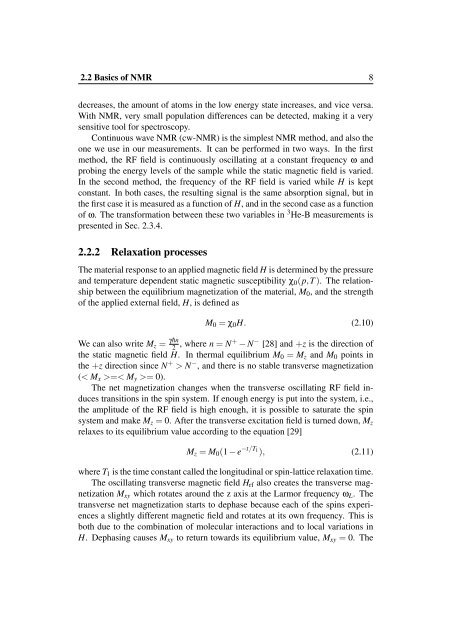NMR Techniques at Liquid Helium Temperatures - Low ...
NMR Techniques at Liquid Helium Temperatures - Low ...
NMR Techniques at Liquid Helium Temperatures - Low ...
Create successful ePaper yourself
Turn your PDF publications into a flip-book with our unique Google optimized e-Paper software.
2.2 Basics of <strong>NMR</strong> 8<br />
decreases, the amount of <strong>at</strong>oms in the low energy st<strong>at</strong>e increases, and vice versa.<br />
With <strong>NMR</strong>, very small popul<strong>at</strong>ion differences can be detected, making it a very<br />
sensitive tool for spectroscopy.<br />
Continuous wave <strong>NMR</strong> (cw-<strong>NMR</strong>) is the simplest <strong>NMR</strong> method, and also the<br />
one we use in our measurements. It can be performed in two ways. In the first<br />
method, the RF field is continuously oscill<strong>at</strong>ing <strong>at</strong> a constant frequency ω and<br />
probing the energy levels of the sample while the st<strong>at</strong>ic magnetic field is varied.<br />
In the second method, the frequency of the RF field is varied while H is kept<br />
constant. In both cases, the resulting signal is the same absorption signal, but in<br />
the first case it is measured as a function of H, and in the second case as a function<br />
of ω. The transform<strong>at</strong>ion between these two variables in 3 He-B measurements is<br />
presented in Sec. 2.3.4.<br />
2.2.2 Relax<strong>at</strong>ion processes<br />
The m<strong>at</strong>erial response to an applied magnetic field H is determined by the pressure<br />
and temper<strong>at</strong>ure dependent st<strong>at</strong>ic magnetic susceptibility χ0(p,T ). The rel<strong>at</strong>ionship<br />
between the equilibrium magnetiz<strong>at</strong>ion of the m<strong>at</strong>erial, M0, and the strength<br />
of the applied external field, H, is defined as<br />
M0 = χ0H. (2.10)<br />
We can also write Mz = γ¯hn<br />
2 , where n = N+ − N − [28] and +z is the direction of<br />
the st<strong>at</strong>ic magnetic field H. In thermal equilibrium M0 = Mz and M0 points in<br />
the +z direction since N + > N − , and there is no stable transverse magnetiz<strong>at</strong>ion<br />
(< Mx >=< My >= 0).<br />
The net magnetiz<strong>at</strong>ion changes when the transverse oscill<strong>at</strong>ing RF field induces<br />
transitions in the spin system. If enough energy is put into the system, i.e.,<br />
the amplitude of the RF field is high enough, it is possible to s<strong>at</strong>ur<strong>at</strong>e the spin<br />
system and make Mz = 0. After the transverse excit<strong>at</strong>ion field is turned down, Mz<br />
relaxes to its equilibrium value according to the equ<strong>at</strong>ion [29]<br />
Mz = M0(1 − e −t/T1 ), (2.11)<br />
where T1 is the time constant called the longitudinal or spin-l<strong>at</strong>tice relax<strong>at</strong>ion time.<br />
The oscill<strong>at</strong>ing transverse magnetic field Hrf also cre<strong>at</strong>es the transverse magnetiz<strong>at</strong>ion<br />
Mxy which rot<strong>at</strong>es around the z axis <strong>at</strong> the Larmor frequency ωL. The<br />
transverse net magnetiz<strong>at</strong>ion starts to dephase because each of the spins experiences<br />
a slightly different magnetic field and rot<strong>at</strong>es <strong>at</strong> its own frequency. This is<br />
both due to the combin<strong>at</strong>ion of molecular interactions and to local vari<strong>at</strong>ions in<br />
H. Dephasing causes Mxy to return towards its equilibrium value, Mxy = 0. The

















